Medial Branch Block vs. Facet Injection: Understanding the Differences
Chronic pain in the lower back and neck can be debilitating, often stemming from issues with the facet joints in the spine. Two common procedures used to diagnose and treat this pain are medial branch blocks and facet injections. While both target the facet joints, they differ significantly in their approach and application. This article will clarify the distinctions between these two procedures, answering common questions surrounding their use and effectiveness.
What is a Medial Branch Block?
A medial branch block (MBB) is a diagnostic and therapeutic procedure used to identify the specific nerve roots causing pain in the spine. A physician uses fluoroscopy (real-time X-ray imaging) to guide a needle precisely to the medial branch nerves, which supply sensory information to the facet joints. A local anesthetic and sometimes a corticosteroid medication is injected to temporarily block these nerves. If the injection provides pain relief, it confirms that the targeted facet joint is the source of the pain. This provides crucial information for guiding further treatment.
What is a Facet Injection?
A facet injection, similar to an MBB, uses fluoroscopy to guide a needle to the facet joint itself. The injection delivers a mixture of local anesthetic and a corticosteroid directly into the joint capsule. The goal of this procedure is to reduce inflammation and pain in the facet joint. Unlike an MBB, which targets the nerves supplying the joint, a facet injection targets the joint directly.
What are the Differences Between Medial Branch Blocks and Facet Injections?
The primary difference lies in the target:
- Medial Branch Block: Targets the medial branch nerves that innervate the facet joint.
- Facet Injection: Targets the facet joint itself.
This difference in target translates to different applications:
- Diagnosis: MBBs are primarily diagnostic. Pain relief following the injection strongly suggests the facet joint is the source of the pain. Facet injections are less frequently used solely for diagnostic purposes.
- Treatment: Both can be therapeutic, providing pain relief. Facet injections often provide longer-lasting pain relief than MBBs, though this is not always the case.
- Duration of Relief: MBBs typically provide short-term pain relief (hours to days), while facet injections offer potentially longer-lasting relief (weeks to months).
Which Procedure is Right for Me?
The decision of whether to undergo an MBB or a facet injection depends on several factors, including:
- The location and nature of your pain: Your doctor will assess the location, intensity, and duration of your pain to determine the most appropriate procedure.
- Your medical history: Pre-existing conditions might influence the choice of procedure.
- The results of other diagnostic tests: Imaging studies such as X-rays or MRIs can help determine the cause of your pain.
Your physician will conduct a thorough evaluation and discuss the risks and benefits of each procedure to help you make an informed decision. It's crucial to discuss your individual circumstances and preferences with your doctor.
What are the Risks and Complications Associated with These Procedures?
Both medial branch blocks and facet injections are generally considered safe procedures, but potential complications exist, including:
- Bleeding or bruising at the injection site: This is a common and usually minor complication.
- Infection: Though rare, infection at the injection site is a possibility.
- Nerve damage: This is a rare complication, but it can occur.
- Headache: This is more common with cervical (neck) injections.
It's essential to communicate any concerns or questions with your doctor before undergoing either procedure. A comprehensive discussion ensures you're well-informed and comfortable with the treatment plan.
How Long Does Pain Relief Last After a Medial Branch Block or Facet Injection?
The duration of pain relief varies significantly depending on the individual and the specific procedure. As mentioned previously, MBBs generally provide shorter-term relief, lasting hours to days. Facet injections offer the potential for longer-lasting relief, ranging from weeks to months, but this isn't guaranteed. In some cases, the pain relief may be temporary, and repeated injections might be necessary. Your doctor can provide a better estimate based on your individual circumstances.
Are Medial Branch Blocks and Facet Injections Covered by Insurance?
Insurance coverage for medial branch blocks and facet injections varies widely depending on the insurance provider, the specific diagnosis, and the medical necessity as determined by your doctor. It's always advisable to contact your insurance company directly to understand your coverage before scheduling the procedure. Your doctor's office can also help you navigate the insurance process.
This information is for educational purposes only and should not be considered medical advice. Always consult with a qualified healthcare professional for diagnosis and treatment of any medical condition.
